Abstract
Previous studies have localized the gene for Waardenburg syndrome (WS) type I to the distal portion of chromosome 2q, near the ALPP locus. We pooled linkage data obtained from 41 WS type I and 3 WS type II families which were typed for six polymorphic loci on chromosome 2q in order to refine the location of the WS locus (WS1) and evaluate the extent of genetic heterogeneity. In the course of this work, we developed diagnostic criteria for genetic and phenotypic studies. Our findings, based on two-locus and multilocus analysis using a linkage map established from reference pedigrees, suggest that there are two or more mutations causing WS, one of which (i.e., WS1) is located on chromosome 2q, between the ALPP and FN1 loci, at distances of 7.8 cM and 11.2 cM for each marker, respectively. The results also indicate that WS1 is responsible for the illness in approximately 45% of all families in this sample. However, the odds favoring this position over a location between ALPP and SAG are only 2:1 when alternate assumptions about the proportion of linked families are considered. We conclude that a more saturated map of this region of chromosome 2q, including highly polymorphic markers, will be needed to accurately distinguish linked families and, ultimately, isolate the mutant gene.
Full text
PDF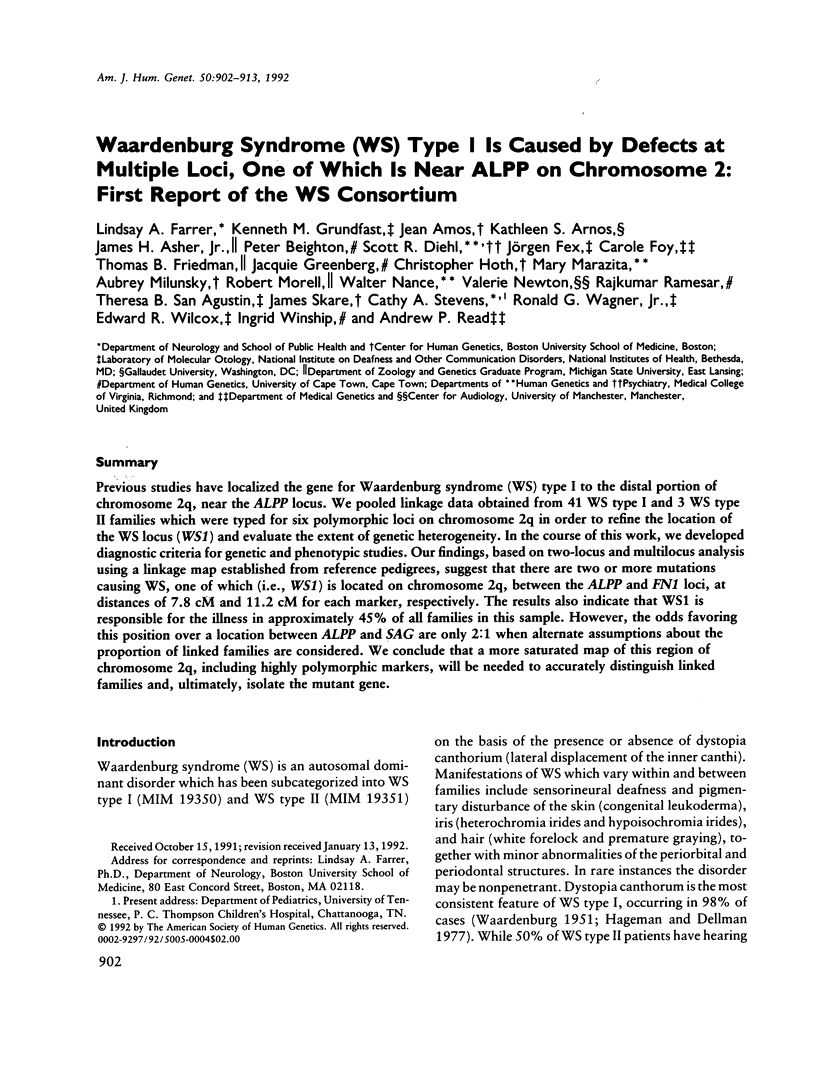
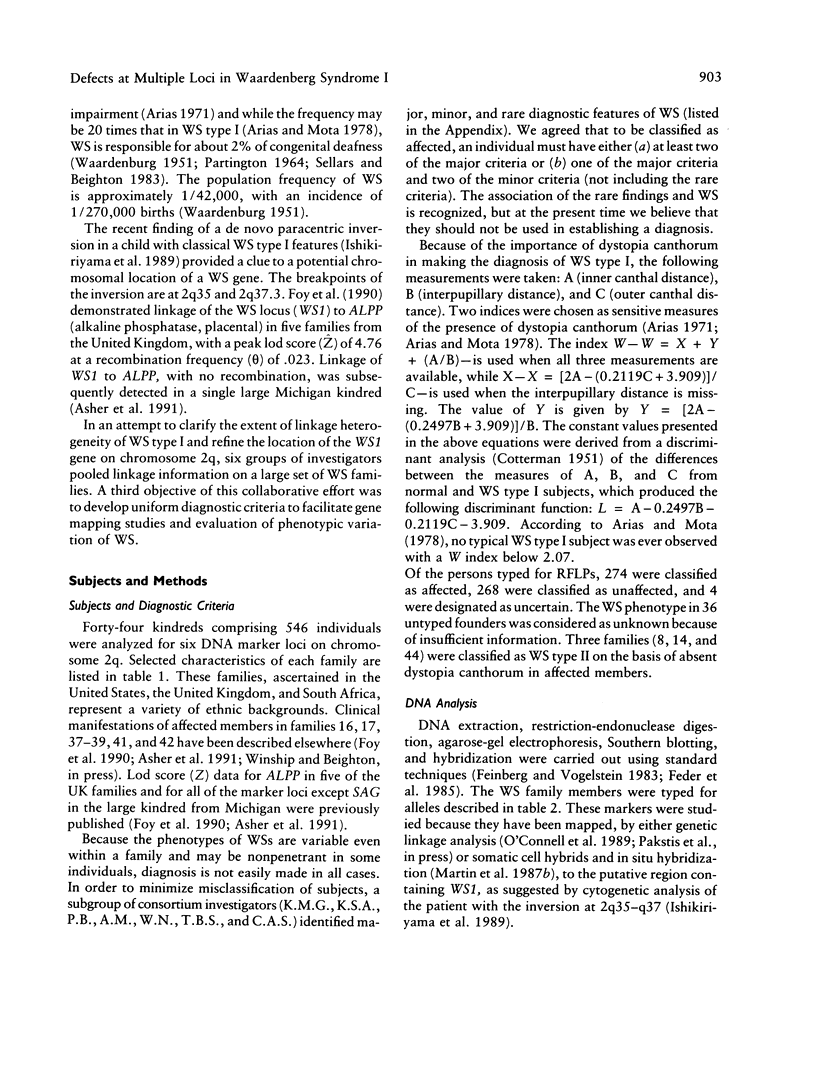
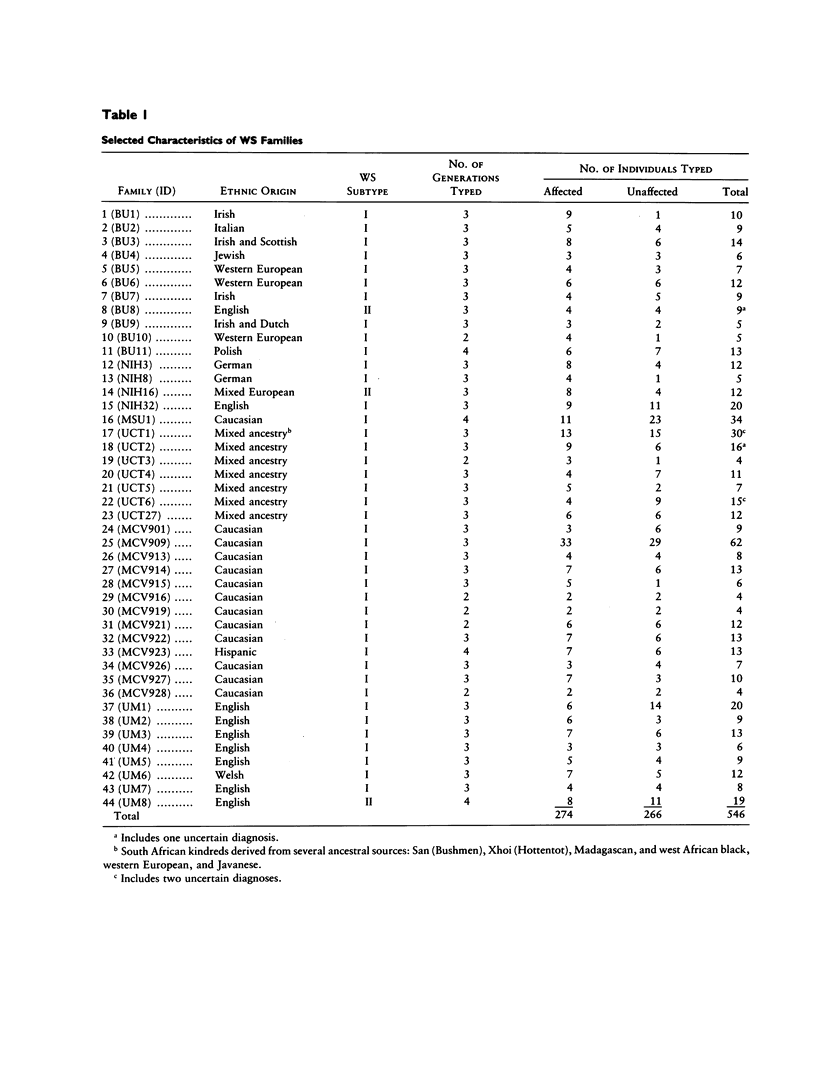
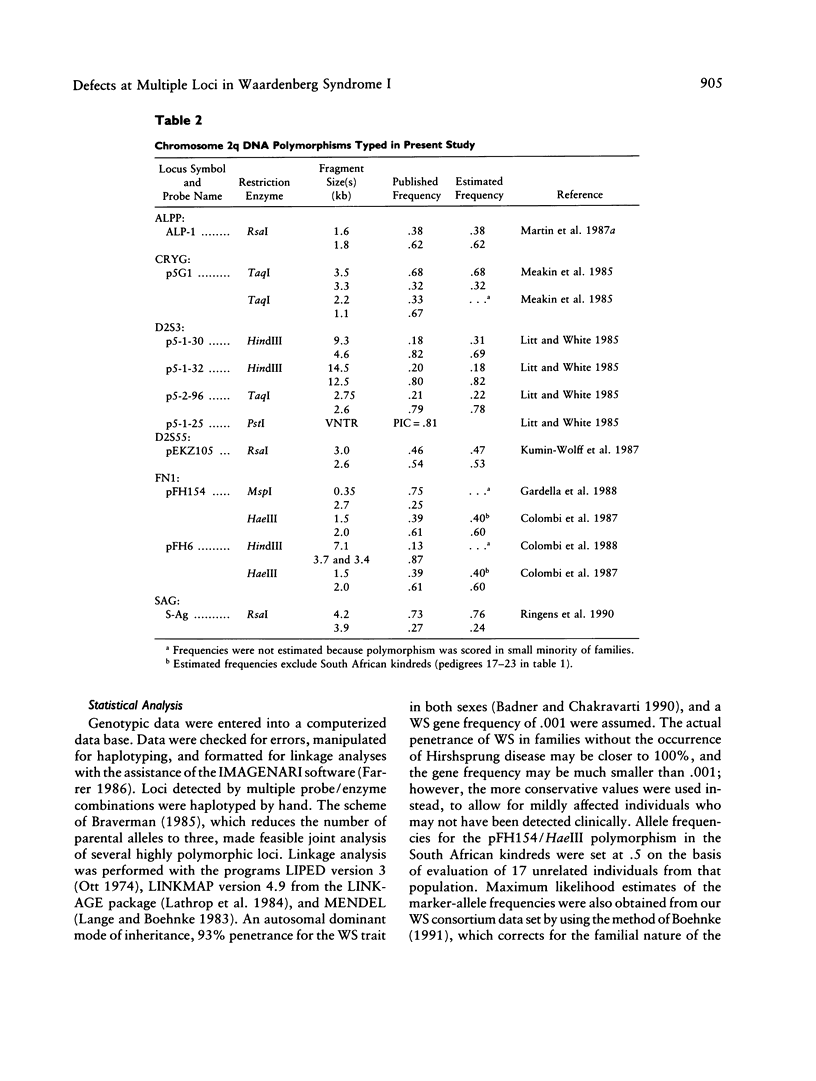
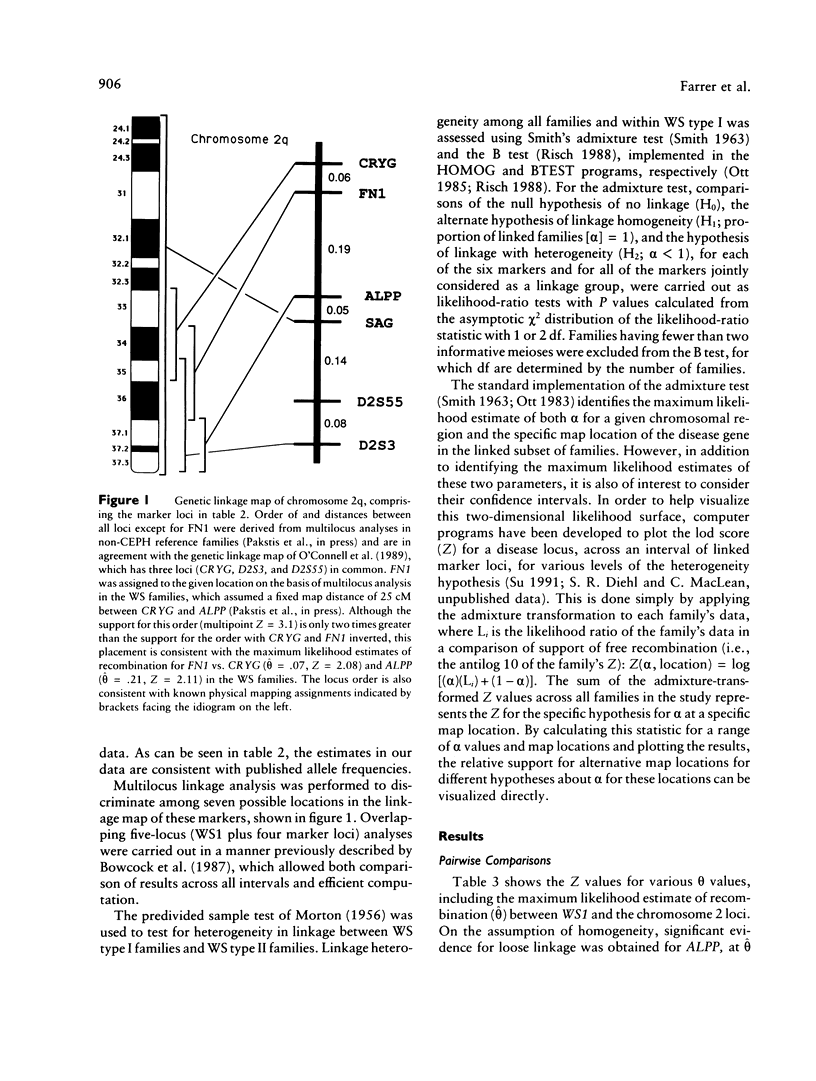
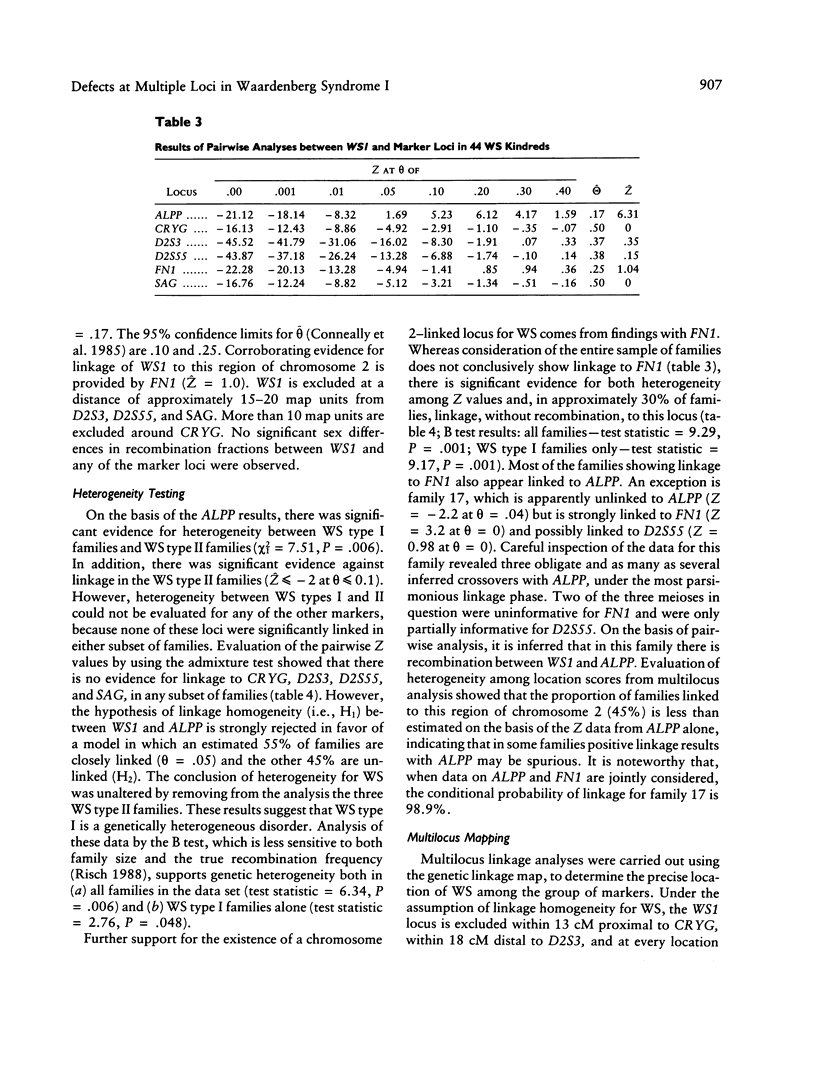

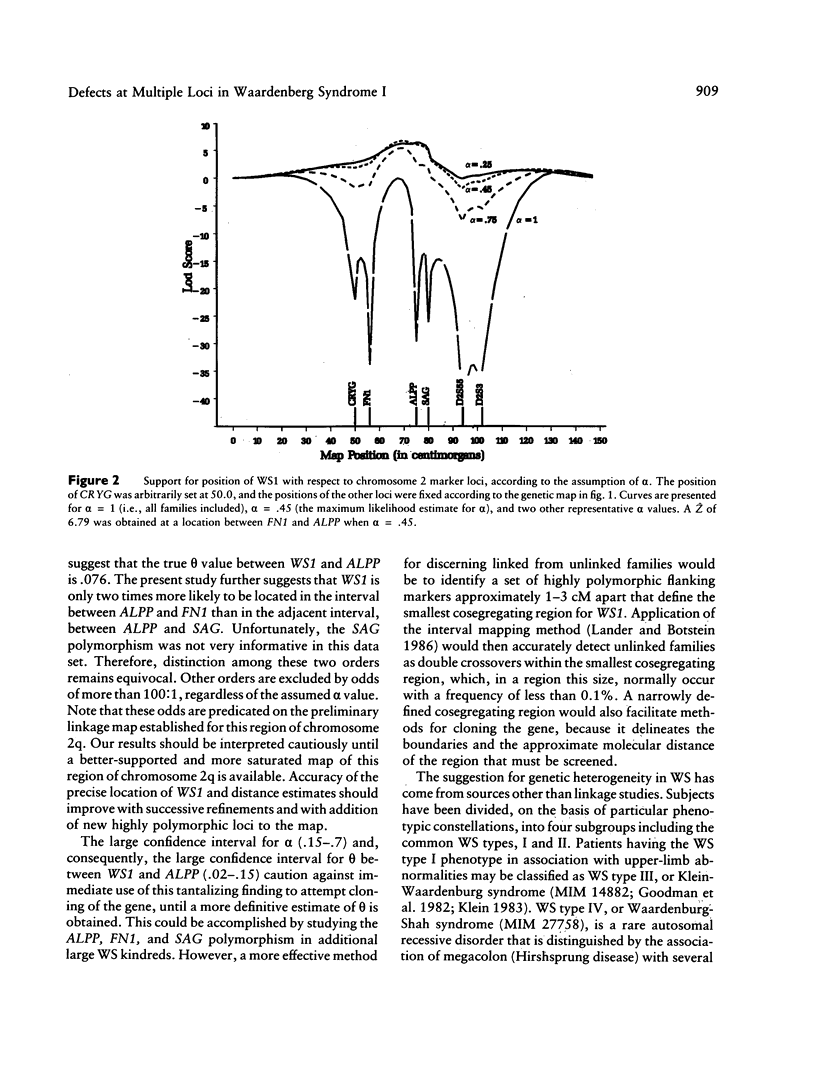
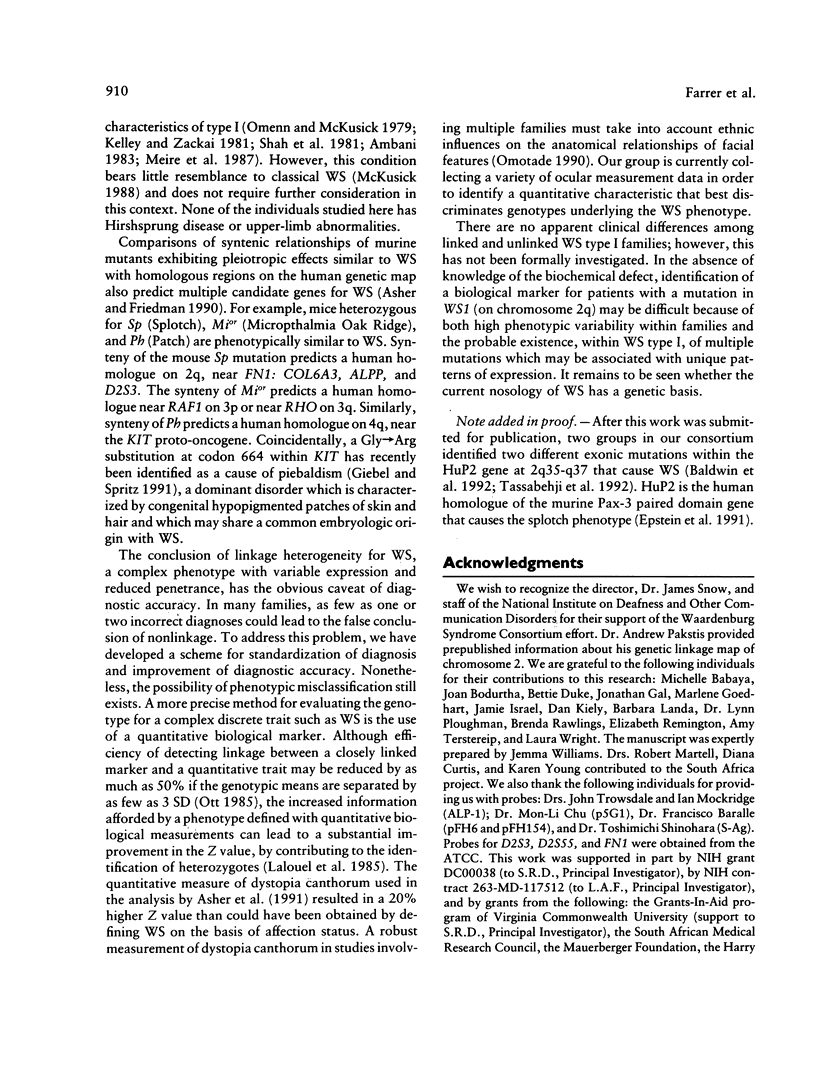
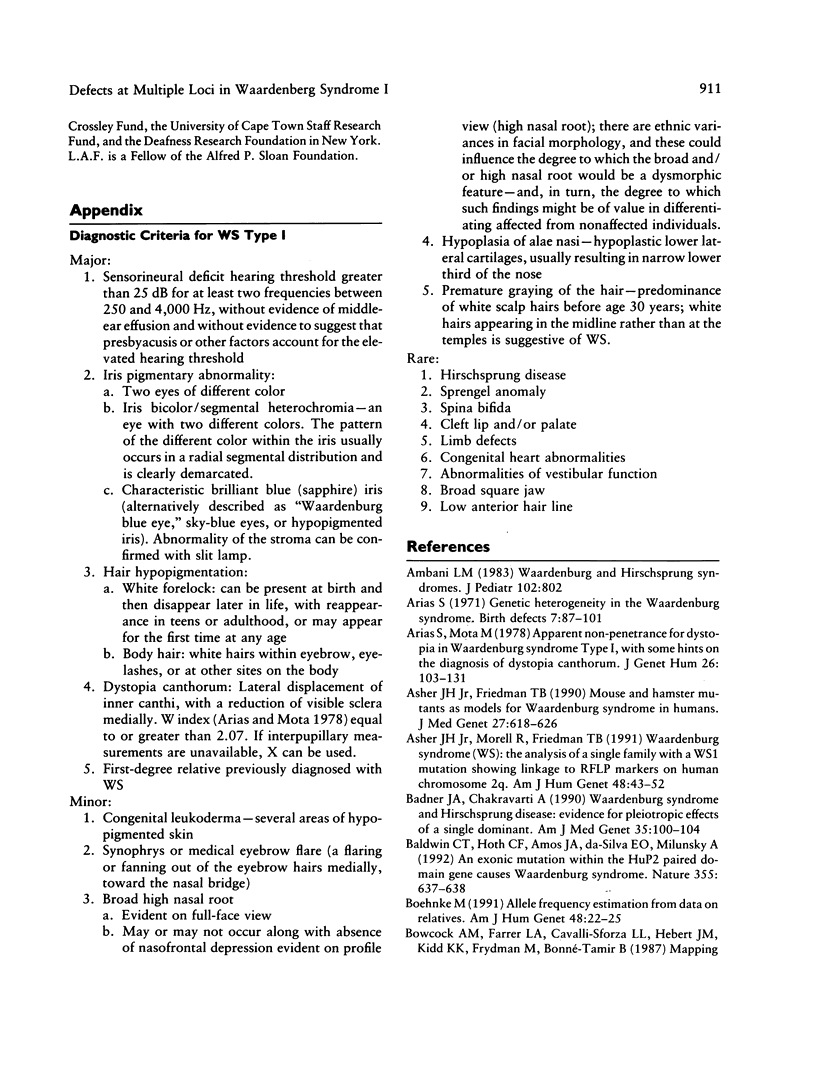
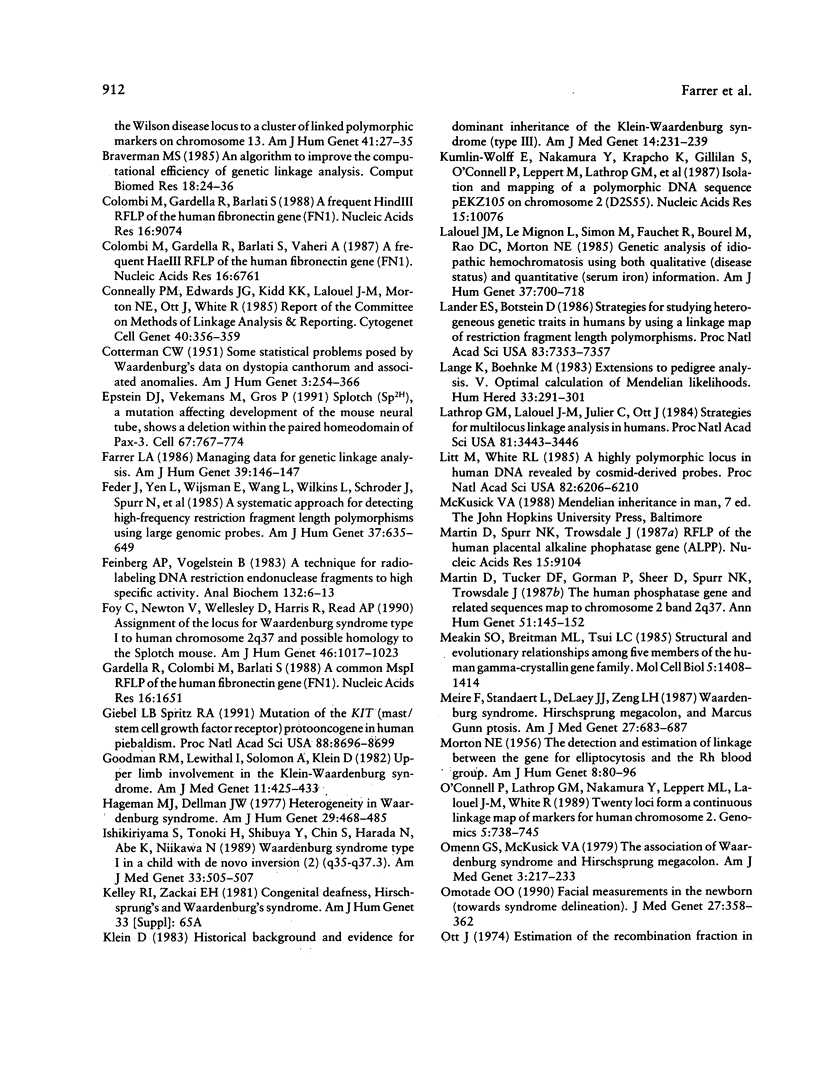
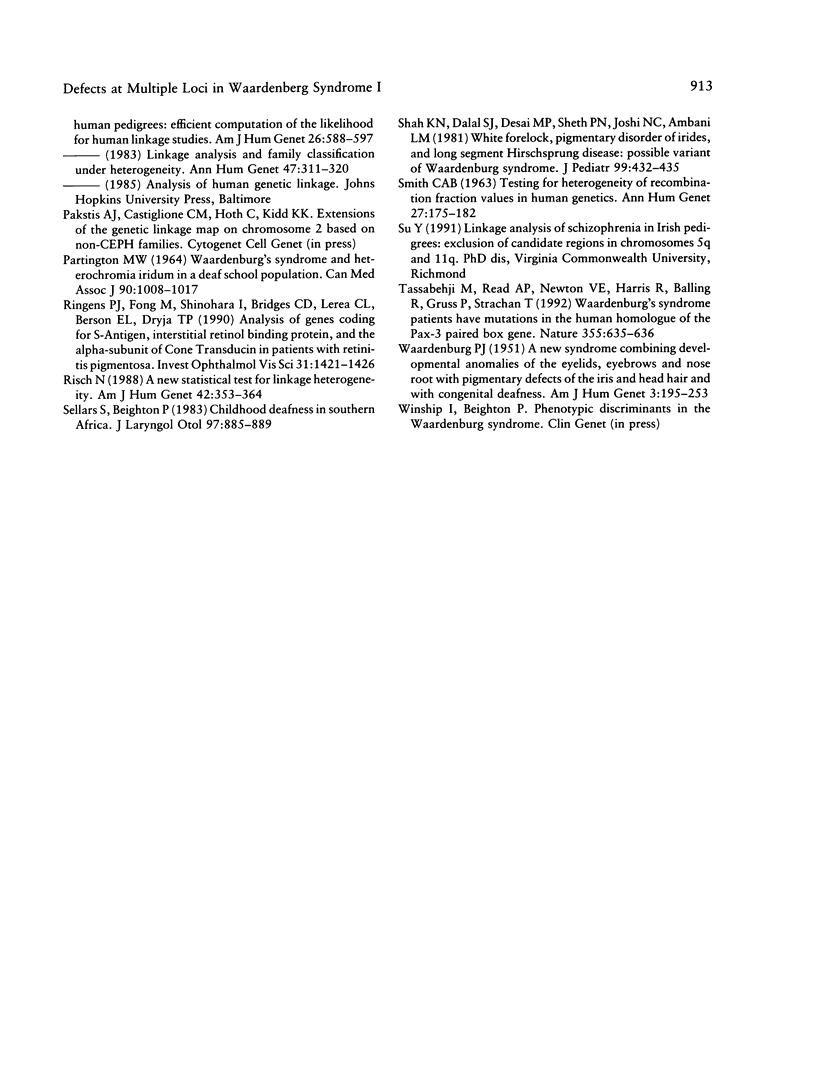
Selected References
These references are in PubMed. This may not be the complete list of references from this article.
- Ambani L. M. Waardenburg and Hirschsprung syndromes. J Pediatr. 1983 May;102(5):802–802. doi: 10.1016/s0022-3476(83)80267-4. [DOI] [PubMed] [Google Scholar]
- Arias S. Genetic heterogeneity in the Waardenburg syndrome. Birth Defects Orig Artic Ser. 1971 Mar;07(4):87–101. [PubMed] [Google Scholar]
- Arias S., Mota M. Apparent non-penetrance for dystopia in Waardenburg syndrome type I, with some hints on the diagnosis of dystopia canthorum. J Genet Hum. 1978 Jun;26(2):103–131. [PubMed] [Google Scholar]
- Asher J. H., Jr, Friedman T. B. Mouse and hamster mutants as models for Waardenburg syndromes in humans. J Med Genet. 1990 Oct;27(10):618–626. doi: 10.1136/jmg.27.10.618. [DOI] [PMC free article] [PubMed] [Google Scholar]
- Asher J. H., Jr, Morell R., Friedman T. B. Waardenburg syndrome (WS): the analysis of a single family with a WS1 mutation showing linkage to RFLP markers on human chromosome 2q. Am J Hum Genet. 1991 Jan;48(1):43–52. [PMC free article] [PubMed] [Google Scholar]
- Badner J. A., Chakravarti A. Waardenburg syndrome and Hirschsprung disease: evidence for pleiotropic effects of a single dominant gene. Am J Med Genet. 1990 Jan;35(1):100–104. doi: 10.1002/ajmg.1320350119. [DOI] [PubMed] [Google Scholar]
- Baldwin C. T., Hoth C. F., Amos J. A., da-Silva E. O., Milunsky A. An exonic mutation in the HuP2 paired domain gene causes Waardenburg's syndrome. Nature. 1992 Feb 13;355(6361):637–638. doi: 10.1038/355637a0. [DOI] [PubMed] [Google Scholar]
- Boehnke M. Allele frequency estimation from data on relatives. Am J Hum Genet. 1991 Jan;48(1):22–25. [PMC free article] [PubMed] [Google Scholar]
- Bowcock A. M., Farrer L. A., Cavalli-Sforza L. L., Hebert J. M., Kidd K. K., Frydman M., Bonne-Tamir B. Mapping the Wilson disease locus to a cluster of linked polymorphic markers on chromosome 13. Am J Hum Genet. 1987 Jul;41(1):27–35. [PMC free article] [PubMed] [Google Scholar]
- Braverman M. S. An algorithm to improve the computational efficiency of genetic linkage analysis. Comput Biomed Res. 1985 Feb;18(1):24–36. doi: 10.1016/0010-4809(85)90004-7. [DOI] [PubMed] [Google Scholar]
- COTTERMAN C. W. Some statistical problems posed by Waardenburg's data on dystopia canthorum and associated anomalies. Am J Hum Genet. 1951 Sep;3(3):254–266. [PMC free article] [PubMed] [Google Scholar]
- Colombi M., Gardella R., Barlati S. A frequent HindIII RFLP of the human fibronectin gene (FN1). Nucleic Acids Res. 1988 Sep 26;16(18):9074–9074. doi: 10.1093/nar/16.18.9074. [DOI] [PMC free article] [PubMed] [Google Scholar]
- Colombi M., Gardella R., Barlati S., Vaheri A. A frequent HaeIII RFLP of the human fibronectin gene. Nucleic Acids Res. 1987 Aug 25;15(16):6761–6761. doi: 10.1093/nar/15.16.6761. [DOI] [PMC free article] [PubMed] [Google Scholar]
- Conneally P. M., Edwards J. H., Kidd K. K., Lalouel J. M., Morton N. E., Ott J., White R. Report of the Committee on Methods of Linkage Analysis and Reporting. Cytogenet Cell Genet. 1985;40(1-4):356–359. doi: 10.1159/000132186. [DOI] [PubMed] [Google Scholar]
- Epstein D. J., Vekemans M., Gros P. Splotch (Sp2H), a mutation affecting development of the mouse neural tube, shows a deletion within the paired homeodomain of Pax-3. Cell. 1991 Nov 15;67(4):767–774. doi: 10.1016/0092-8674(91)90071-6. [DOI] [PubMed] [Google Scholar]
- Farrer L. A. Managing data for genetic linkage analysis. Am J Hum Genet. 1986 Jul;39(1):146–147. [PMC free article] [PubMed] [Google Scholar]
- Feder J., Yen L., Wijsman E., Wang L., Wilkins L., Schroder J., Spurr N., Cann H., Blumenberg M., Cavalli-Sforza L. L. A systematic approach for detecting high-frequency restriction fragment length polymorphisms using large genomic probes. Am J Hum Genet. 1985 Jul;37(4):635–649. [PMC free article] [PubMed] [Google Scholar]
- Feinberg A. P., Vogelstein B. A technique for radiolabeling DNA restriction endonuclease fragments to high specific activity. Anal Biochem. 1983 Jul 1;132(1):6–13. doi: 10.1016/0003-2697(83)90418-9. [DOI] [PubMed] [Google Scholar]
- Foy C., Newton V., Wellesley D., Harris R., Read A. P. Assignment of the locus for Waardenburg syndrome type I to human chromosome 2q37 and possible homology to the Splotch mouse. Am J Hum Genet. 1990 Jun;46(6):1017–1023. [PMC free article] [PubMed] [Google Scholar]
- Gardella R., Colombi M., Barlati S. A common MspI RFLP of the human fibronectin gene (FN1). Nucleic Acids Res. 1988 Feb 25;16(4):1651–1651. doi: 10.1093/nar/16.4.1651. [DOI] [PMC free article] [PubMed] [Google Scholar]
- Giebel L. B., Spritz R. A. Mutation of the KIT (mast/stem cell growth factor receptor) protooncogene in human piebaldism. Proc Natl Acad Sci U S A. 1991 Oct 1;88(19):8696–8699. doi: 10.1073/pnas.88.19.8696. [DOI] [PMC free article] [PubMed] [Google Scholar]
- Goodman R. M., Lewithal I., Solomon A., Klein D. Upper limb involvement in the Klein-Waardenburg syndrome. Am J Med Genet. 1982 Apr;11(4):425–433. doi: 10.1002/ajmg.1320110407. [DOI] [PubMed] [Google Scholar]
- Hageman M. J., Delleman J. W. Heterogeneity in Waardenburg syndrome. Am J Hum Genet. 1977 Sep;29(5):468–485. [PMC free article] [PubMed] [Google Scholar]
- Ishikiriyama S., Tonoki H., Shibuya Y., Chin S., Harada N., Abe K., Niikawa N. Waardenburg syndrome type I in a child with de novo inversion (2)(q35q37.3). Am J Med Genet. 1989 Aug;33(4):505–507. doi: 10.1002/ajmg.1320330419. [DOI] [PubMed] [Google Scholar]
- Klein D. Historical background and evidence for dominant inheritance of the Klein-Waardenburg syndrome (type III). Am J Med Genet. 1983 Feb;14(2):231–239. doi: 10.1002/ajmg.1320140205. [DOI] [PubMed] [Google Scholar]
- Kumlin-Wolff E., Nakamura Y., Krapcho K., Gillilan S., O'Connell P., Leppert M., Lathrop G. M., Lalouel J. M., White R. Isolation and mapping of a polymorphic DNA sequence pEKZ105 on chromosome 2 (D2S55). Nucleic Acids Res. 1987 Dec 10;15(23):10076–10076. doi: 10.1093/nar/15.23.10076. [DOI] [PMC free article] [PubMed] [Google Scholar]
- Lalouel J. M., Le Mignon L., Simon M., Fauchet R., Bourel M., Rao D. C., Morton N. E. Genetic analysis of idiopathic hemochromatosis using both qualitative (disease status) and quantitative (serum iron) information. Am J Hum Genet. 1985 Jul;37(4):700–718. [PMC free article] [PubMed] [Google Scholar]
- Lander E. S., Botstein D. Strategies for studying heterogeneous genetic traits in humans by using a linkage map of restriction fragment length polymorphisms. Proc Natl Acad Sci U S A. 1986 Oct;83(19):7353–7357. doi: 10.1073/pnas.83.19.7353. [DOI] [PMC free article] [PubMed] [Google Scholar]
- Lange K., Boehnke M. Extensions to pedigree analysis. V. Optimal calculation of Mendelian likelihoods. Hum Hered. 1983;33(5):291–301. doi: 10.1159/000153393. [DOI] [PubMed] [Google Scholar]
- Lathrop G. M., Lalouel J. M., Julier C., Ott J. Strategies for multilocus linkage analysis in humans. Proc Natl Acad Sci U S A. 1984 Jun;81(11):3443–3446. doi: 10.1073/pnas.81.11.3443. [DOI] [PMC free article] [PubMed] [Google Scholar]
- Litt M., White R. L. A highly polymorphic locus in human DNA revealed by cosmid-derived probes. Proc Natl Acad Sci U S A. 1985 Sep;82(18):6206–6210. doi: 10.1073/pnas.82.18.6206. [DOI] [PMC free article] [PubMed] [Google Scholar]
- MORTON N. E. The detection and estimation of linkage between the genes for elliptocytosis and the Rh blood type. Am J Hum Genet. 1956 Jun;8(2):80–96. [PMC free article] [PubMed] [Google Scholar]
- Martin D., Spurr N. K., Trowsdale J. RFLP of the human placental alkaline phosphatase gene (PLAP). Nucleic Acids Res. 1987 Nov 11;15(21):9104–9104. doi: 10.1093/nar/15.21.9104. [DOI] [PMC free article] [PubMed] [Google Scholar]
- Martin D., Tucker D. F., Gorman P., Sheer D., Spurr N. K., Trowsdale J. The human placental alkaline phosphatase gene and related sequences map to chromosome 2 band q37. Ann Hum Genet. 1987 May;51(Pt 2):145–152. doi: 10.1111/j.1469-1809.1987.tb01056.x. [DOI] [PubMed] [Google Scholar]
- Meakin S. O., Breitman M. L., Tsui L. C. Structural and evolutionary relationships among five members of the human gamma-crystallin gene family. Mol Cell Biol. 1985 Jun;5(6):1408–1414. doi: 10.1128/mcb.5.6.1408. [DOI] [PMC free article] [PubMed] [Google Scholar]
- Meire F., Standaert L., De Laey J. J., Zeng L. H. Waardenburg syndrome, Hirschsprung megacolon, and Marcus Gunn ptosis. Am J Med Genet. 1987 Jul;27(3):683–686. doi: 10.1002/ajmg.1320270322. [DOI] [PubMed] [Google Scholar]
- O'Connell P., Lathrop G. M., Nakamura Y., Leppert M. L., Lalouel J. M., White R. Twenty loci form a continuous linkage map of markers for human chromosome 2. Genomics. 1989 Nov;5(4):738–745. doi: 10.1016/0888-7543(89)90115-8. [DOI] [PubMed] [Google Scholar]
- Omenn G. S., McKusick V. A. The association of Waardenburg syndrome and Hirschsprung megacolon. Am J Med Genet. 1979;3(3):217–223. doi: 10.1002/ajmg.1320030302. [DOI] [PubMed] [Google Scholar]
- Omotade O. O. Facial measurements in the newborn (towards syndrome delineation) J Med Genet. 1990 Jun;27(6):358–362. doi: 10.1136/jmg.27.6.358. [DOI] [PMC free article] [PubMed] [Google Scholar]
- Ott J. Estimation of the recombination fraction in human pedigrees: efficient computation of the likelihood for human linkage studies. Am J Hum Genet. 1974 Sep;26(5):588–597. [PMC free article] [PubMed] [Google Scholar]
- PARTINGTON M. W. WAARDENBURG'S SYNDROME AND HETEROCHROMIA IRIDUM IN A DEAF SCHOOL POPULATION. Can Med Assoc J. 1964 Apr 25;90:1008–1017. [PMC free article] [PubMed] [Google Scholar]
- Ringens P. J., Fang M., Shinohara T., Bridges C. D., Lerea C. L., Berson E. L., Dryja T. P. Analysis of genes coding for S-antigen, interstitial retinol binding protein, and the alpha-subunit of cone transducin in patients with retinitis pigmentosa. Invest Ophthalmol Vis Sci. 1990 Aug;31(8):1421–1426. [PubMed] [Google Scholar]
- Risch N. A new statistical test for linkage heterogeneity. Am J Hum Genet. 1988 Feb;42(2):353–364. [PMC free article] [PubMed] [Google Scholar]
- SMITH C. A. TESTING FOR HETEROGENEITY OF RECOMBINATION FRACTION VALUES IN HUMAN GENETICS. Ann Hum Genet. 1963 Nov;27:175–182. doi: 10.1111/j.1469-1809.1963.tb00210.x. [DOI] [PubMed] [Google Scholar]
- Sellars S., Beighton P. Childhood deafness in southern Africa. An aetiological survey of 3,064 deaf children. J Laryngol Otol. 1983 Oct;97(10):885–889. doi: 10.1017/s0022215100095736. [DOI] [PubMed] [Google Scholar]
- Shah K. N., Dalal S. J., Desai M. P., Sheth P. N., Joshi N. C., Ambani L. M. White forelock, pigmentary disorder of irides, and long segment Hirschsprung disease: possible variant of Waardenburg syndrome. J Pediatr. 1981 Sep;99(3):432–435. doi: 10.1016/s0022-3476(81)80339-3. [DOI] [PubMed] [Google Scholar]
- Tassabehji M., Read A. P., Newton V. E., Harris R., Balling R., Gruss P., Strachan T. Waardenburg's syndrome patients have mutations in the human homologue of the Pax-3 paired box gene. Nature. 1992 Feb 13;355(6361):635–636. doi: 10.1038/355635a0. [DOI] [PubMed] [Google Scholar]
- WAARDENBURG P. J. A new syndrome combining developmental anomalies of the eyelids, eyebrows and nose root with pigmentary defects of the iris and head hair and with congenital deafness. Am J Hum Genet. 1951 Sep;3(3):195–253. [PMC free article] [PubMed] [Google Scholar]


